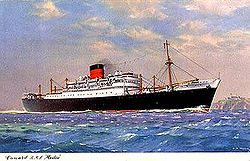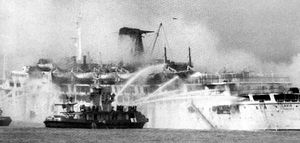SS Lavia
 RMS Media | |
| Career | |
|---|---|
| Name: |
Media (1946-61} Flavia (1961-82) Flavian (1983-86) Lavia (1986-89) |
| Owner: |
Cunard White Star Line (1947-50) Cunard Line (1950-61) Compagnia Genovese de Armamento SpA (1961-69) Costa Armatori SpA (1969-82) Flavian Shipping SA (1982-86) Lavia Shipping SA (1986-89) |
| Operator: |
Cunard White Star Line (1947-50) Cunard Line (1950-61) Cogedar Line (1961-69) Costa Line (1969-82) C Y Tung Group (1982-86) Virtue Shipping Company (1986-89) |
| Port of registry: |
22x20px Genoa (1961-82) 22x20px Panama City (1982-89) |
| Route: |
Liverpool - New York (1947-61) Bremerhaven - Rotterdam - Tilbury - Curacao - Panama Canal - Papeete - Auckland - Sydney - Melbourne - Fremantle - Aden - Suez Canal - Port Said - Cannes - Tilbury - Rotterdam - Bremerhaven (1962-67) Bremerhaven - Rotterdam - Tilbury - Curacao - Panama Canal - Papeete - Auckland - Sydney - Melbourne - South Africa - Tilbury - Rotterdam - Bremerhaven (1967-68) Miami - Bahamas (1968-77, 1978-82) |
| Builder: | John Brown & Co Ltd, Clydebank |
| Yard number: | 629 |
| Launched: | 12 December 1946 |
| Completed: | August 1947 |
| Maiden voyage: | 20 August 1947 |
| Identification: |
UK Official Number 181093 (1947-61) Italian Official Number 3260 (1961-69) Italian Official Number 1069 (1969-82) IMO Number 5116139 (1961-89) |
| Fate: | Caught fire 7 January 1989, scrapped June 1989 |
| General characteristics | |
| Type: |
Cargo liner (1947-61) Ocean liner (1961-69) Cruise ship (1969-89) |
| Tonnage: |
13,345 GRT, 11,636 DWT (1947-61) 15,456 GRT (1961-89) |
| Length: |
531 feet (161.85 m) (1947-61) 557 feet (169.77 m) (1961-89) |
| Beam: | 70 feet (21.34 m) |
| Draught: | 26 feet (7.92 m) |
| Installed power: | Two steam turbines 15,000 horsepower (11,000 kW), double reduction geared |
| Propulsion: | Twin propellors |
| Speed: | 18 knots (33 km/h) |
| Capacity: |
250 1st class (Media) 1,320 tourist class (Flavia) 850 tourist class (Flavian, Lavia) |
Lavia was a cruise ship which caught fire and sank in Hong Kong Harbour in 1989. She was built for Cunard White Star Line in 1947 as the cargo liner Media. In 1961 she was sold to Italy, rebuilt as an ocean liner and renamed Flavia. In 1969, she was refitted as a cruise ship and renamed Flavian. In 1982 she was sold to Panama and renamed Lavia. She was undergoing a refit when the fire occurred. The damage to her was so great that she was scrapped.
Contents
History
Media
Media was built by John Brown & Company, Clydebank, West Dunbartonshire.[1] She was yard number 629 and was launched on 12 December 1947, with completion in August 1948.[2]
Media and her sister ship Parthia were Cunard's first postwar ships. They were built for the Liverpool - New York route. Each ship carried 250 first class passengers and had good cargo capacity. Media made her maiden voyage from Liverpool to New York on 20 August 1947. In 1953, Media underwent a refit, and was fitted with Denny Brown fin stabilisers, the first transatlantic liner so fitted. The reduction in rolling that the stablilsers produced made for a much more comfortable crossing. So successful were the stablilisers that they were fitted to RMS Queen Mary and RMS Queen Elizabeth too.[3] By the late 1950s, Media's market for passengers was being taken by transatlantic jet aircraft, such as the Comet and 707. New cargo ships entering service were also faster than Media, reducing her suitability for use on that trade.[1]
Flavia
In July 1961, Media was sold for £740,000 to the Italian Cogedar Line to replace their Flaminia. She remained in service with Cunard until 30 September. On 12 October she was handed over in Liverpool, arriving at Genoa on 21 October. A nine month refit by Officine A & R Navi, Genoa transformed her from a cargo liner to an ocean liner. A new bow increased her length by 26 feet (7.92 m) and a new funnel was provided.[3] The refit increased her displacement from 13,345 GRT to 15,465 GRT.[2] She could now carry 1,320 tourist class passengers. The ship was renamed Flavia and used for round the world cruises and to transport emigrants to Australia.[1] on 2 October 1962, Flavia departed from Genoa on her maiden voyage for the Cogedar Line. Sailing via the Suez Canal she visited Fremantle, Melbourne and Sydney, arriving on 9 October. Departing from Sydney on 10 October, she sailed to Bremerhaven, which was to be her base for round the world cruises.[3]
The route that Flavia took on her round the world cruises was Bremerhaven - Rotterdam - Tilbury - Curaçao - Panama Canal - Papeete - Auckland - Sydney - Melbourne - Fremantle - Aden - Suez Canal - Port Said - Cannes - Tilbury - Rotterdam - Bremerhaven. With the closure of the Suez Canal in 1967 as a result of the Six Day War, Flavia sailed via South Africa on her return to Europe.[3] In 1968, the Cogedar Line was taken over by the Costa Line.[1] She was refitted with her accommodation upgraded and a reduction in berths to 850 passengers transformed her into a cruise ship. She was used for cruises from Miami to the Bahamas until July 1977. She was then used for cruises in South America until April 1978, followed by Mediterranean cruises until September 1978, following which she resumed service on the Miami - Bahamas cruises.[3] By the early 1980s, Flavia was showing her age and was becoming too expensive to operate.[1]
Flavian
She was sold to the Virtue Shipping Company of Hong Kong and renamed Flavian. It was intended to use her as a casino cruise ship but these cruises were unpopular and Flavian spent the majority of the time moored in Hong Kong Harbour.[1]
Lavia
In 1982, the ship was renamed Lavia and a refit was started. On 7 January 1989, a workman's fire got out of control. It spread throughout the ship although all nine crew and 35 workmen on board escaped unharmed. Four fireboats and over 250 firefighters tackled the blaze but Lavia sank owing to the vast amounts of water pumped aboard her in an effort to put out the flames. The ship was refloated and towed to Taiwan,[1] where she arrived on 19 June. She was scrapped by Chi Shun Hia Steel Co Ltd, Kaohsiung.[2]
Description and propulsion
Media was 531 feet (161.85 m) long, with a beam of 70 feet (21.34 m) and a draught of 26 feet (7.92 m).[3] She was propelled by two steam turbines of 15,000 horsepower (11,000 kW),[4] double reduction geared, driving twin propellors.[3] These gave her a speed of 18 knots (33 km/h).[4] After her rebuild by Officine A & R Navi, Flavia was 557 feet (169.77 m) long.[3] As built, she was 13,345 GRT and 11,636 DWT, following her rebuild, she was 15,465 GRT.[4]
Identification
Media had the United Kingdom Official Number 181093 from 1947-61. In 1961, the ship was allocated the IMO Number 5116139. Flavia also had the Italian Official Number 3260 from 1961-69 and 1069 from 1969-82.[2]
References
- ↑ 1.0 1.1 1.2 1.3 1.4 1.5 1.6 Eastlake, Keith (1998). Sea Disasters, the truth behind the tragedies. London N7: Greenwich Editions. pp. p46-47. ISBN 0-86288-149-8.
- ↑ 2.0 2.1 2.2 2.3 ""5116139"" (subscription required). Miramar Ship Index. R.B. Haworth. http://www.miramarshipindex.org.nz. Retrieved 15 November 2009.
- ↑ 3.0 3.1 3.2 3.3 3.4 3.5 3.6 3.7 "Cogedar Line SS Flavia, ex Cunard Line SS Media". Reubens Goossens. http://www.ssmaritime.com/flavia.htm. Retrieved 15 November 2009.
- ↑ 4.0 4.1 4.2 "S/S MEDIA." (in Swedish). Fakta om Fartyg. http://www.faktaomfartyg.se/media_1947.htm. Retrieved 15 November 2009.
External links
- Pages using duplicate arguments in template calls
- Pages with broken file links
- Clyde-built ships
- 1947 ships
- Cargo liners
- Ships of the Cunard Line
- Steamships of the United Kingdom
- Passenger ships of the United Kingdom
- Cruise ships
- Steamships of Italy
- Passenger ships of Italy
- Steamships of Panama
- Passenger ships of Panama
- Ship fires
- Maritime incidents in 1989

